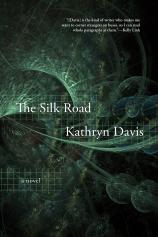The Silk Road
Review
The Silk Road
The Tibetan Book of the Dead is a sacred Buddhist scripture that offers guidance for the transition from life to death, a liminal space known as the “bardo,” and a means to ease the self into a favorable rebirth. This text, exploring existence and meaning, is noted as “among the animating spirits” by Kathryn Davis in the acknowledgements of her latest novel, THE SILK ROAD. Perhaps keeping this inspiration in mind would help readers navigate this complex and cerebral book. It follows a group of adults, apparently siblings, called the Astronomer, the Archivist, the Botanist, the Keeper, the Topologist, the Geographer, the Cook and the Iceman, as they journey toward a vague destination and remember the small details and large emotions of their lives together and apart.
The tale begins with the brothers and sisters in a yoga class inside a labyrinth, led by a teacher named Jee Moon. They are all in the corpse pose, almost hearing each other’s thoughts, aware of the door leading to a tunnel. It was a room, Davis writes, “filled with people who knew the world was coming to an end and that if we worked at it hard enough we would never die.” But someone in the class does die, and the siblings set out along the Silk Road, though their destination is not quite clear --- perhaps a hospital, perhaps the afterlife, perhaps rebirth.
"THE SILK ROAD is not an easy novel, but it is compelling and smart, full of big ideas and still focused on tiny details. Mesmerizing and dreamy, it warrants a second, even a third, reading."
The road is at once post-apocalyptic and medieval. There is a plague, an illness to avoid, but they are driven by a survival instinct and distracted by memories, especially of a shared childhood and of loves and losses of life partners. Together they remember their frightening but lovely mother, their distant but loving father, the nanny who actually raised them, and the treasures found in the old piece of furniture by their front door.
For Buddhists, the ultimate goal is nirvana, extinguishment and the release from the cycle of rebirth. Achievement of this objective may take many lifetimes, and while not all Buddhists agree on the concept of the bardo, a metaphysical space between life and death, THE SILK ROAD riffs on this idea and uses it to great effect. “The Silk Road,” readers are told, “is a conduit not merely for precious commodities, for spices and jewels, mirrors and honey, but for everything strange and unknown, a variety of alien gods and ideas, an unbounded universe with nothing outside it, the dung-covered eggs of the silkworm.” The Silk Road is traveled by all, the Silk Thread is each individual lifetime.
There are dogs, fleas, games, sex, yogic poses, shrines, passages and pathways, song lyrics and literary references galore in THE SILK ROAD, though there is not always clarity. Who are these characters? Literal siblings? Archetypes? A single person with a complex set of responses and thoughts? And what exactly is the Road? The path from disaster to safety? From health to illness? From birth to death? Davis does not provide easy answers but many tantalizing hints and clues along the way, challenging readers and ultimately allowing them to decide for themselves. Clearly the universal is described, poetically and strangely, in this particular, loose-in-time journey.
THE SILK ROAD is not an easy novel, but it is compelling and smart, full of big ideas and still focused on tiny details. Mesmerizing and dreamy, it warrants a second, even a third, reading.
Reviewed by Sarah Rachel Egelman on March 8, 2019
The Silk Road
- Publication Date: March 5, 2019
- Genres: Fiction
- Hardcover: 144 pages
- Publisher: Graywolf Press
- ISBN-10: 1555978290
- ISBN-13: 9781555978297




